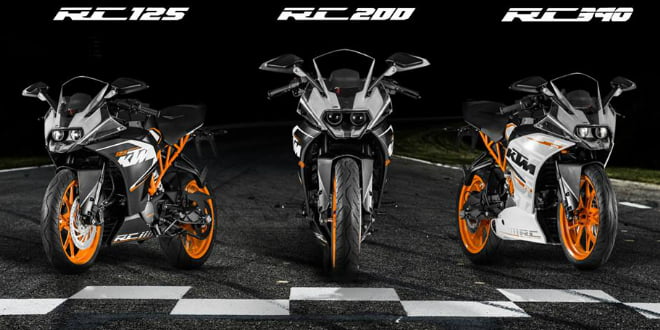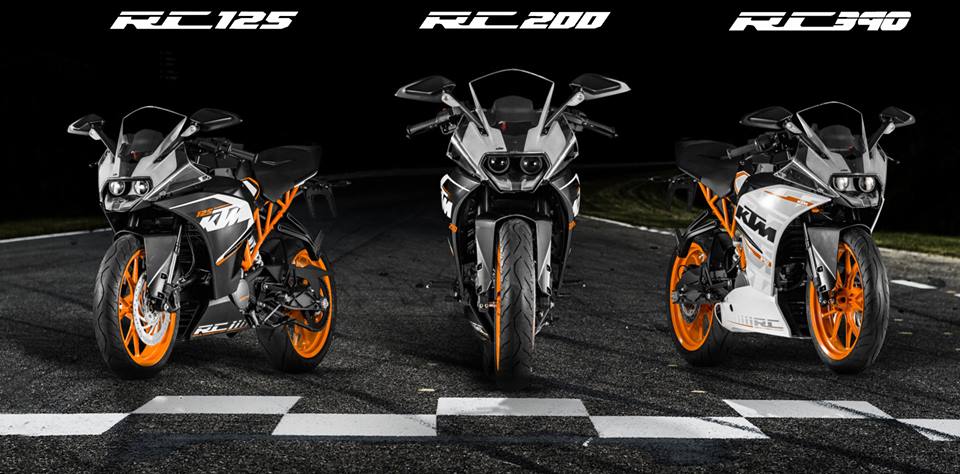You read it first on Car Blog India.
In an interaction with journalists here in Delhi, Mr. Rajiv Bajaj, MD, Bajaj Auto and Mr. Stefan Pierer, CEO, KTM Sportmotorcycles AG have revealed that the KTM RC series supersport bikes will be manufactured at the company’s plant in Chakan, Maharashtra. The RC Series of bikes includes the RC 125, the RC 200 and the RC 390. The RC series of bikes is KTMs take on the fully faired sports bike concept, they look, feel and sound as radical as any other KTM bike.
Apart from making the bikes here, KTM has confirmed that they will launch the bikes in India too. KTM has been showcasing the various RC bikes at the ‘Orange Day’ events it holds around the country. The decision to launch the bike in India was taken after receiving an overwhelming interest in the fully-faired bikes. Read more about the RC series of bikes below:
The basic frame used on all the RC Series of bikes is a modified version of the steel trellis frame found on the Duke street series of bikes. The frame has a shorter trail, a shorter wheelbase and increased ground clearance to give the bikes a more track performance oriented handling characteristic. Most of the tech used on these bikes were first developed on the KTM 1190 RC8 R, the company’s most powerful bike before the 1290 Super Duke R came along. The suspension, the steering, the brakes and the instruments on the bikes have been borrowed from the RC8 and it’s track-only version.
Features across the series include an aerodynamic wind-shield that protects the riders face and chest during high speed riding and also makes the bike more slippery through the air. A aerodynamic tank that has crevices that help the rider grip the bike which in turn improves handling ability, the aerodynamic design also helps with less fuel-consumption even when the bike is ridden hard for a long duration. The two part seat is typical sports bike design, KTM promising that the seats will be comfortable both for the rider and the pillion. Last but not least the clip-on handlesbars and the rear-set footpegs provide the rider with a very sporty seating position which complements the intend of the bike and provides for better handling too.
The engines on the bikes are the same as the road/street bikes except that these have been tuned for sportsbike like performance and feel. As the name of the bikes suggest, the RC 125, the RC 200 and the RC 390 are powered by a 125cc, 200cc and a 373cc engine respectively. The technical specifications of the bikes are as follows:
KTM RC 125
- 15 BHP, single-cylinder, water-cooled engine.
- 6-speed, toe-shifting transmission
- 125mm travel WP Suspension inverted shocks at front, 150mm travel WP Suspension mono-shock at rear
- 300mm front disc brake with four-pot calipers, 230mm rear disc with single-pot caliper
- ABS which can be fully dis-engaged
- 17-inch wheels front and back, 110mm section tyre at front and 150mm section tyre at rear
- 10-litre fuel tank
- 1135 Kg unladen weight.
KTM RC 200
- 25 BHP, single-cylinder, liquid-cooled engine.
- 6-speed, toe-shifting transmission
- 125mm travel WP Suspension inverted shocks at front, 150mm travel WP Suspension mono-shock at rear
- 300mm front disc brake with four-pot calipers, 230mm rear disc with single-pot caliper
- ABS which can be fully dis-engaged
- 17-inch wheels front and back, 110mm section tyre at front and 150mm section tyre at rear
- 10-litre fuel tank
- 137.5 Kg unladen weight.
KTM RC 390
- 43 BHP, single-cylinder, water-cooled engine.
- 6-speed, toe-shifting transmission
- 125mm travel inverted shocks at front, 150mm travel mono-shock at rear
- 300mm front disc brake with four-pot calipers, 230mm rear disc with single-pot caliper
- ABS which can be fully dis-engaged
- 17-inch wheels front and back, 110mm section tyre at front and 150mm section tyre at rear
- 10-litre fuel tank
- 147 Kg unladen weight.
Which bike are you looking forward to the most? Let us know in comments section below.



